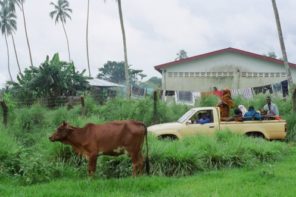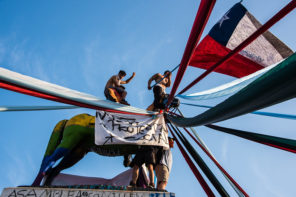This is finally it! I unlock my bike, hop on and start making my way down the hill in the direction of the lake. Shivering slightly from the damp morning air, I pass the Cornavin station, and make sure that I am not caught in the tram tracks going in all directions across the road.
For a moment I hesitate if I am heading the right way, but then I begin to recognize familiar places; although it has been a few years since my last visit to Geneva, the centre of the town is so small that it is easy enough to find one’s way around. In just a few more minutes I am navigating through Paquis, thinking how, despite of liking the city much more in all other aspects in my present visit, this area truly remains a ‘dump’ as I have heard locals describe it affectionately. I make one final curve to the left, and see the Palais Wilson on my right.
I chain my bike at the fence going around the Palais, and pause for a moment to admire the building: it is every bit as beautiful as I remembered. I proceed toward the security booth located at the gate, holding my passport tightly in my hand and hoping that my badge has arrived there as promised. It has not. Disappointed, for a moment I fear that I will end up wasting too much time sorting the matter out, and thus miss the opening of the session. This prospect does not please me – I am here to watch the entire session from start to finish in order to get the full picture of what a session of the Human Rights Committee looks like. Fortunately the issue is resolved in just a few moments after the security guards make a couple of calls to someone inside the Palais. I never find out why my pass was not ready or how the matter is fixed but that matters little: I am let in.
I thank the guards warmly for going out of their way to accommodate my participation, and – feeling a bit like an academic Cinderella – make my way to the inner yard. I cannot help but feel that there is something magical in the building in front of me: whereas all the other gorgeous houses on its either side contain just ‘normal’ activities, this is the place where ‘the international’ meets. I pause at this thought for a moment, only to be jerked back into reality by the sound of rushed footsteps as people making up ‘the international’ pass me by from all sides. I glance quickly at their wardrobe, hoping that I fit in: I have swapped my unfortunately characteristic writing sweats for a classic tailored jacket, smart pants and heels, but I still fear that the academic within may be peeking out. Cinderella all right – even if I would not necessarily call my fieldwork ‘studying up’, it certainly does includes dressing up. I finally reach the front door, make my way up the short staircase and find myself in the impressive front lobby where I am greeted by the equally striking view of the Lac Léman. In just a few moments yet another session of the UN Human Rights Committee would be opened. I hang my coat in the wardrobe next to the Session venue and cannot help but think: I have arrived.
These fieldnotes embody some of my first experiences of doing fieldwork at the UN Human Rights Committee as I prepare to set out for yet another fieldwork period in October. During the past year I have attended the 107th and 108th Session of the Committee held respectively in March and July of 2013, and in the following weeks I will complement these experiences by following the Committee’s 109th Session. In the previous sessions I have conducted participant-observation in all the events that were open to the public at the Palais Wilson, headquarters of the UN Office of the UN High Commissioner for Human Rights. I have complemented this ethnographic material with interviews with members of the Human Rights Committee, NGO representatives and the UN secretariat, as well as discussions with representatives of the UN Congress services, press secretaries and interpreters. I have also followed (or more specifically, attempted to follow) NGO delegates and state delegates around the Palais and Geneva as they participate in the proceedings, and spent any moments spared from these diverse experiences by hanging out in the cafeteria of the Palais in order to observe the unfolding of the sociality accompanying the Committee’s session.
Importantly – whether at lunch time at the cafeteria or breaks in between sessions – I have been able to contextualize my general presence of monitoring the Session by associating myself with the group to which I bear the closest external similarity (with a bit of a stretch of the imagination), thus gaining also a useful social identity from a well-embedded category for the Committee’s operations. With this I refer to the category of ‘the intern’; the steady stream of young scholars (usually phd students) who act as the private assistants of treaty body members, and who are through these experiences being socialized into the UN bureaucracy.
My fieldwork is part of a project that has in some ways been already ongoing for quite a while – I first began studying the compilation of state reports submitted to UN human rights treaty bodies at the Finnish Ministry of Foreign Affairs in Autumn 2009 (Halme-Tuomisaari and Huotari 2012; Halme-Tuomisaari 2012) – in other ways is just starting as, ignoring a few short prior visits, these sessions have formed my first substantial fieldwork period at the UN. Yet, the operations of treaty bodies are in different ways highly familiar to me from my decade-long query into the contemporary ‘human rights phenomenon’, which would have hardly been possible without due recognition of the role the UN as an integral part of the entire phenomenon’s unfolding (Halme-Tuomisaari 2010).

To contextualize my fieldnotes a few cursory notes on the role and functioning of UN human rights treaty bodies is helpful. In the absence of an international human rights tribunal operating for example under the auspices of the UN, the nine treaty bodies that exist on the basis of treaty provisions are the highest international monitoring and implementing bodies for human rights covenants. Although treaty bodies are commonly called as being ‘court-like’, in their operations they are far more flexible than courts; also both the legal status of the bodies themselves as well as the documents that they process and produce is ambiguous under international law.[1]
In concrete treaty bodies are committees formed of 15-25 individuals who are nationals of states, which are parties to the treaties in question. Although treaty bodies faced previously frequent charges of being ‘politicised’ and including as their members senior government officials lacking substantive human rights expertise who instead represented the interests of their governments, today members are increasingly individuals seen as human rights experts. By their professional status they are commonly academics usually from within the different branches of the law, or acting judges. The Human Rights Committee monitoring compliance with the International Covenant on Civil and Political Rights (ICCPR) is one of the oldest of the treaty bodies, and it is widely regarded as the most authoritative or important of them; this view is commonly also forwarded by the Committee’s members. Certainly the profile of the Committee’s members holds a high emphasis of legal background as illustrated by the fact that of the Committee’s current members only one has a background in a field other than international or domestic law. The relationship of treaty bodies and law, including the attempts to ‘legalize’ their work, forms an ongoing source of fascination for my research, and it is one of the issues that I continue to observe and elaborate as my venture unfolds.
The main form of operations for treaty bodies is formed by the ‘reporting cycles’ in which treaty bodies receive and process the state reports composed by states and submitted by the intervals stipulated by the treaties, usually once in approximately five years. The culmination of these cycles is the already mentioned ‘constructive dialogue’ between state representatives and treaty body members which takes place at the UN either in New York and increasingly in Geneva which is also the headquarters of the Office of the UN High Commissioner for Human Rights. In reality intervals between reports vary as both state parties and treaty bodies assisted by the Secretariat of the UN Office for the High Commissioner for Human Rights face sever delays and backlogs. This situation forms a key reasons for the ongoing pressures to reorganize and ‘streamline’ the operations of treaty bodies; a process for which numerous proposals are circulating at present as they have continued to circulate during the entire existence of the treaty body system.
In addition to state reports, treaty bodies receive and process individual petitions where so provided by the relevant treaty, as well as additional ‘shadow’ reports compiled and submitted by NGOs to complement the reports of state parties. I have in another context discussed the importance of these reports by pointing out how they reflect the growing global importance of implicit knowledge held by human rights experts, which through different bureaucratic practices at the UN, among others, contributes to the erosion of the institute of the state, and generates new political subjectivities. I have further argued that although the intensified centrality of NGOs is commonly viewed as being positive, it also undermines public political processes by replacing them with a private realm of interest struggles governed by activist strategies and expert knowledge (Halme-Tuomisaari 2013). In my fieldnotes I continue discussing the role of NGOs with the aim of offering further theoretizations on how their role in treaty body proceedings impacts their role in international law and international collaboration more generally.
In my previous fieldwork periods I have structured my observations around five themes, most of which remain largely untheorized and have at the present moment as their primary aim to offer a sense of ‘time’, ‘place’ and ‘people’ around the Committee’s proceedings. In the following weeks I attempt to continue exploring these themes and also accompany them with more theoretical reflections where possible. The first theme I have tentatively titled “From “Real Reality” to ‘UN reality’”, and through this title I attempt to offer a general description of the sessions of the Human Rights Committee as well as to describe how they might appear to ‘the newcomer’. I also discuss the relationship that treaty body sessions hold to the surrounding ‘real’ world, as opposed to being seen as forming an ‘insider’s club’.[3]
With the second theme I will attempt to address the relationship of the Human Rights Committee to the other UN human rights monitoring mechanisms by focusing in specific on whether and how the Universal Period Review (UPR) process, the recently established monitoring mechanism by the Human Rights Council, is discussed by the Human Rights Committee. My preliminary observations suggest that inter-links are surprisingly scarce, and in the instances that I have encounter so far I interpret their tenor to speak in particular of attempts to defend the legitimate and authoritative position of treaty bodies which are currently under great pressures for reformation. I will continue with this theme in my forthcoming observations, and consider what kind of further avenues that this material opens up for considering the UN human rights monitoring framework as a whole, and the role of treaty bodies in general and the Human Rights Committee in specific as a part of this framework.
My third area of focus has been on NGOs, particularly the techniques through which NGOs make their claims both visible and audible in treaty body proceedings; an element that I am planning to elaborate later with a discussion on the notions of ‘temporality’ around treaty bodies. The fourth area of focus has been on NGOs, yet this time by focusing on the people for whom NGO work forms both a profession and a passion. The last theme I have explored relates to the notion of time – the concrete moments of beginning and ending of the Committee’s sessions by fleshing out the various thoughts that the beginning and ending of the Session awakened in me as moments with which ‘the international’ first comes into being, and at the end vanishes. By emphasizing these sentiments I want to continue with my experiments, undertaken also by the preceding glimpses offered this paper, to find ways of bringing ‘the people’ into the equation.
Here I wish to draw attention to the various depictions of UN operations – with the official press releases offering merely one exemplary genre – which are usually characterized by a highly de-personalized tenor devoid of names, personalities, senses of humor or strong emotions. Yet, I argue that all of these elements are cardinal for understanding both the operations of this global organization as a whole and the continued impact that the organization has the capacity to induce on a global level; given that it remains difficult to measure or somehow objectively show what the UN actually achieves in the world, I find its continued global relevance to emanate increasingly from the diverse feelings that people invest in the organization (see Navaro-Yashin 2013).
Emphasizing emotions is also relevant for how I treat the material I have acquired through interviews: as important as I see interview material being in offering ‘real information’, to me it is at minimum as important, if not more, in offering me insight into the common conceptions, illusions, fantasies and myths invested in UN human rights operations by the various engaged actors’: for example, is the UN seen “an embodiment of efforts to change the world”, as one young intern phrased the matter, or a “dysfunctional organisation that cares little for its employees”, as a seasoned member of the UN secretariat phrased the issue? These themes form a vastly under-explored area of UN operations, yet they are crucially important in ‘making the organisation real’ by the actors who participate in its work both in Geneva, and around the world.
The 109th Session of the UN Human Rights Committee takes place between October 14 and November 1, 2013, at the Palais Wilson, in Geneva.
[1] Recent years have seen the appearance of a great number of contributions discussing UN human rights treaty bodies and the future of the UN human rights regulatory framework more generally; see (Rodley 2003; Keller and Ulfstein 2012; Comstock 2009; Megret 2012; Egan 2011; Tyagi 2011; Freedman 2013; Odello and Seatzu 2012; Vandenhole 2004; Clark 2011; Young 2002; Joseph, Schultz, and Castan 2005; Kamminga and Scheinin 2009; Bassiouni and Schabas 2011; Cole 2012; O’Flaherty and Ulrich 2010; Bayefsky 2000)
[2] Relevant discussions here include the recent anthropological work on treaty bodies and the international human rights regime, see among others (Merry 2006; Goodale 2012; Dembour 2006; Dembour and Kelly 2007); the ethnography of document; see among others (Riles 2006) and Navaro-Yashin 2013, as well as the anthropology of organizations and bureaucracy; and the study of experts (references to be added)
[3] With the exception of the NGO delegation of Hong Kong I use pseudonyms for all the individuals I refer to; for the present working paper I have chosen simply names from Finnish. I will proceed to discuss this choice as my fieldwork continues.
This glimpse is connected to my ongoing study of the UN Human Rights Committee. The next part of my Fieldnotes of the Committee’s 109th session can be read here.











